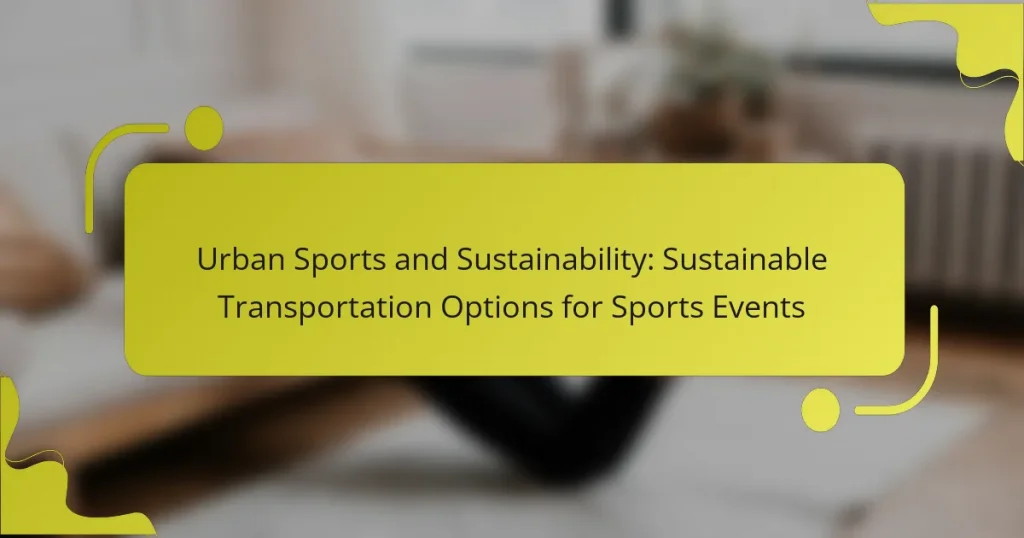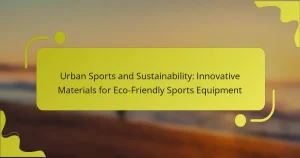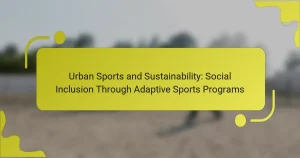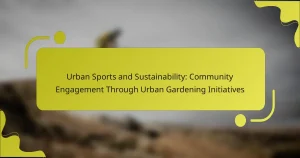Sustainable transportation options are crucial for reducing the environmental impact of urban sports events. This article explores public transit, cycling, carpooling, and electric vehicles as eco-friendly alternatives. It also examines regional strategies for implementing these options and highlights the benefits of sustainability in sports. Lastly, the role of innovative technologies in enhancing transportation efficiency will be discussed.

What are the environmental impacts of urban sports events?
Urban sports events can significantly impact the environment through increased carbon emissions, waste generation, and resource consumption. Sustainable transportation options, such as public transit and cycling, can mitigate these effects. For instance, promoting bike-sharing programs and shuttle services reduces traffic congestion and lowers emissions. Implementing eco-friendly practices, like waste sorting and recycling, further enhances sustainability. Engaging local communities in environmental initiatives fosters awareness and participation, creating a positive legacy for future events.
How do transportation choices affect carbon footprints?
Transportation choices significantly impact carbon footprints by determining the emissions generated during travel. Sustainable transportation options, such as public transit, cycling, and walking, reduce carbon output compared to personal vehicles. For example, public transit can lower greenhouse gas emissions by up to 45% per passenger mile compared to single-occupancy cars. Additionally, the use of electric vehicles and carpooling can further diminish carbon footprints at sports events. Implementing these sustainable practices not only benefits the environment but also enhances the overall experience of attendees.
Which materials and practices contribute to sustainability?
Sustainable materials and practices for urban sports events include eco-friendly transportation options, renewable energy sources, and waste reduction strategies. These practices minimize environmental impact and enhance event sustainability.
Key materials and practices are:
– Electric vehicles for transportation
– Bicycles and pedestrian pathways
– Biodegradable event materials
– Recycling and composting programs
– Renewable energy for powering venues
– Sustainable sourcing of food and beverages
Implementing these options contributes significantly to reducing carbon footprints at sports events.
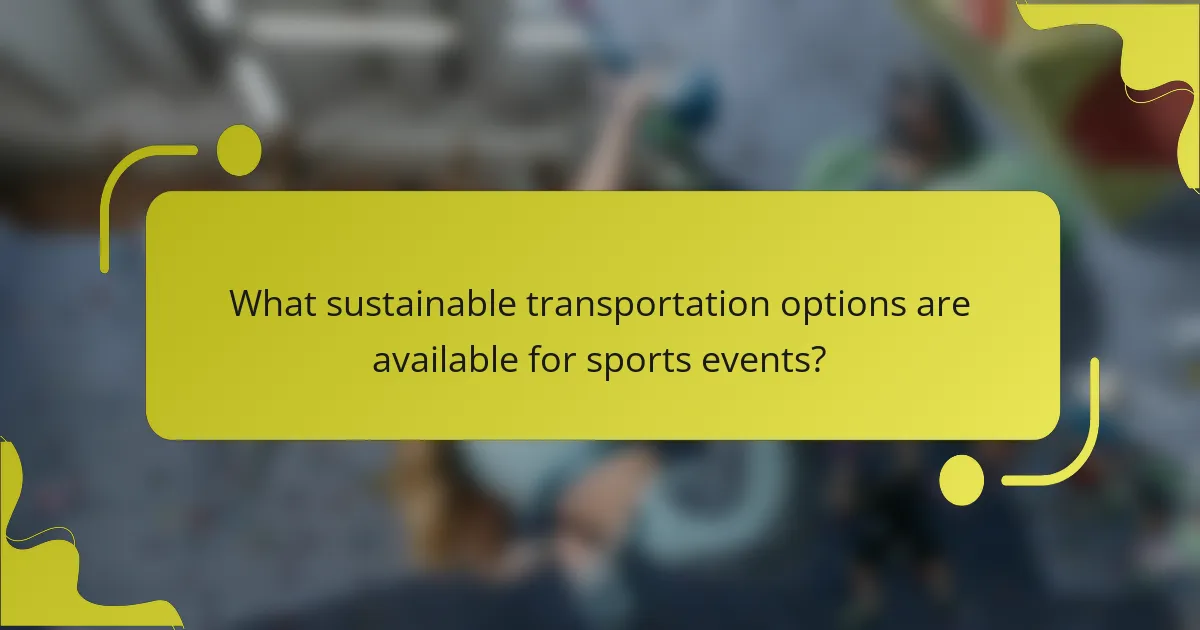
What sustainable transportation options are available for sports events?
Sustainable transportation options for sports events include public transit, cycling, carpooling, and electric vehicles. These options reduce carbon emissions and enhance accessibility.
Public transit systems can accommodate large crowds efficiently, minimizing traffic congestion. Cycling promotes health and reduces environmental impact. Carpooling encourages community engagement and decreases the number of vehicles on the road. Electric vehicles provide a cleaner alternative for attendees traveling longer distances.
Incorporating these transportation methods supports urban sustainability goals and enhances the overall experience of sports events.
How can public transportation enhance event accessibility?
Public transportation significantly enhances event accessibility by providing affordable and efficient travel options. It reduces traffic congestion and environmental impact, promoting sustainable transportation for sports events. Public transit systems can accommodate large crowds, ensuring attendees reach venues easily. Additionally, integrating transit routes with event schedules increases convenience and encourages attendance.
What role do cycling and walking play in event logistics?
Cycling and walking significantly enhance event logistics by promoting sustainable transportation and reducing congestion. These modes of transport minimize carbon emissions and encourage healthier lifestyles. Events that integrate cycling and walking often see improved accessibility and participant satisfaction. Additionally, they can lower transportation costs and create a positive community impact.
Which electric vehicle solutions are most effective for event transport?
Electric vehicles (EVs) such as electric buses, vans, and rideshare options are effective for event transport. These solutions reduce emissions and enhance sustainability at sports events.
Electric buses can transport large groups, with capacities ranging from 30 to 100 passengers. Electric vans offer flexibility for smaller groups, accommodating up to 15 passengers. Rideshare services with electric vehicles provide convenient options for attendees, promoting carpooling and reducing traffic congestion.
Utilizing EVs contributes to lower carbon footprints and aligns with sustainability goals. As a result, many sports organizations prioritize electric transportation to meet environmental standards and enhance the attendee experience.
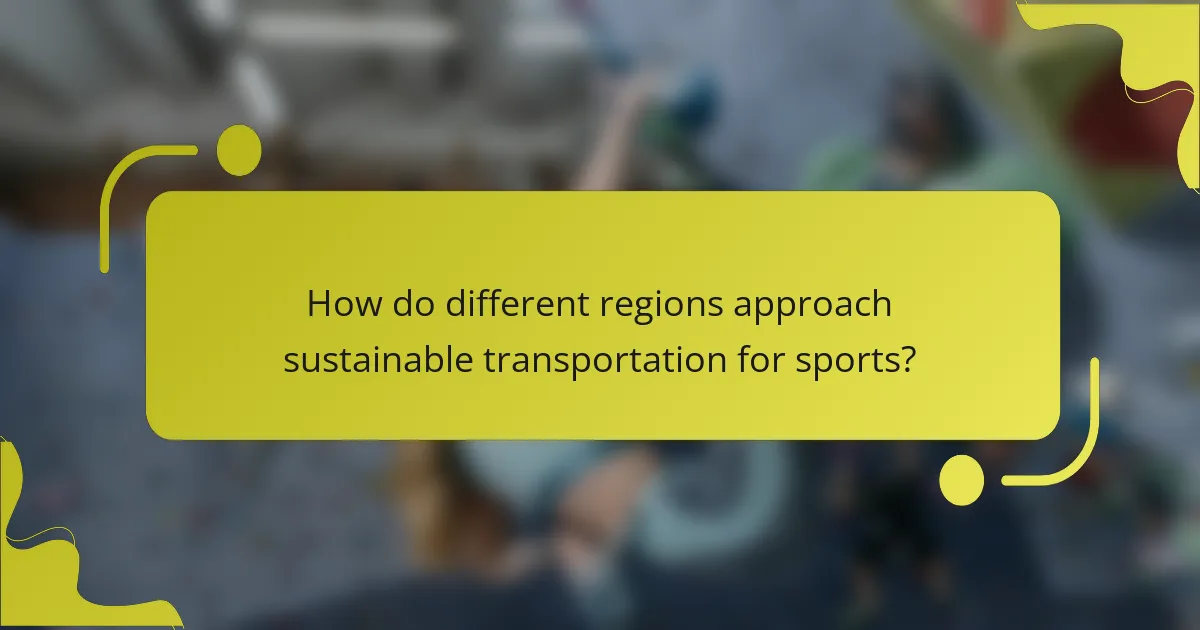
How do different regions approach sustainable transportation for sports?
Different regions adopt varied strategies for sustainable transportation at sports events, emphasizing eco-friendliness and accessibility. For instance, European cities often prioritize public transit integration, providing dedicated lanes for buses and bicycles. In contrast, North American regions may focus on carpooling initiatives and electric vehicle charging stations to support event attendees.
Asia frequently utilizes innovative technologies, such as mobile apps for ride-sharing and real-time public transport updates, enhancing user experience. Additionally, some regions implement carbon offset programs, encouraging participants to minimize their environmental footprint. These diverse approaches reflect local priorities and infrastructure, showcasing a commitment to sustainability in urban sports contexts.
What are the unique challenges faced by urban areas in sustainability efforts?
Urban areas face unique challenges in sustainability efforts, particularly in sustainable transportation for sports events. High population density strains existing infrastructure, leading to increased traffic congestion and pollution. Limited public transportation options hinder accessibility to venues, complicating event logistics. Additionally, urban areas often deal with budget constraints, making it difficult to implement eco-friendly initiatives. The need for collaboration among stakeholders adds another layer of complexity, as aligning interests can be challenging. Finally, changing public attitudes towards sustainable practices requires ongoing education and engagement.
Which successful case studies exemplify best practices in sustainable transport?
Successful case studies in sustainable transport for sports events include initiatives that prioritize eco-friendly practices. Notable examples are the London 2012 Olympics, which utilized public transport and cycling, and the 2016 Rio Olympics, which integrated electric vehicles into their fleet. The use of car-free zones during events promotes pedestrian access and reduces emissions. Additionally, the recent Tokyo 2020 Olympics showcased a commitment to sustainability through the use of hydrogen fuel cells for transport. These cases highlight effective strategies for reducing the carbon footprint of large-scale sports events.
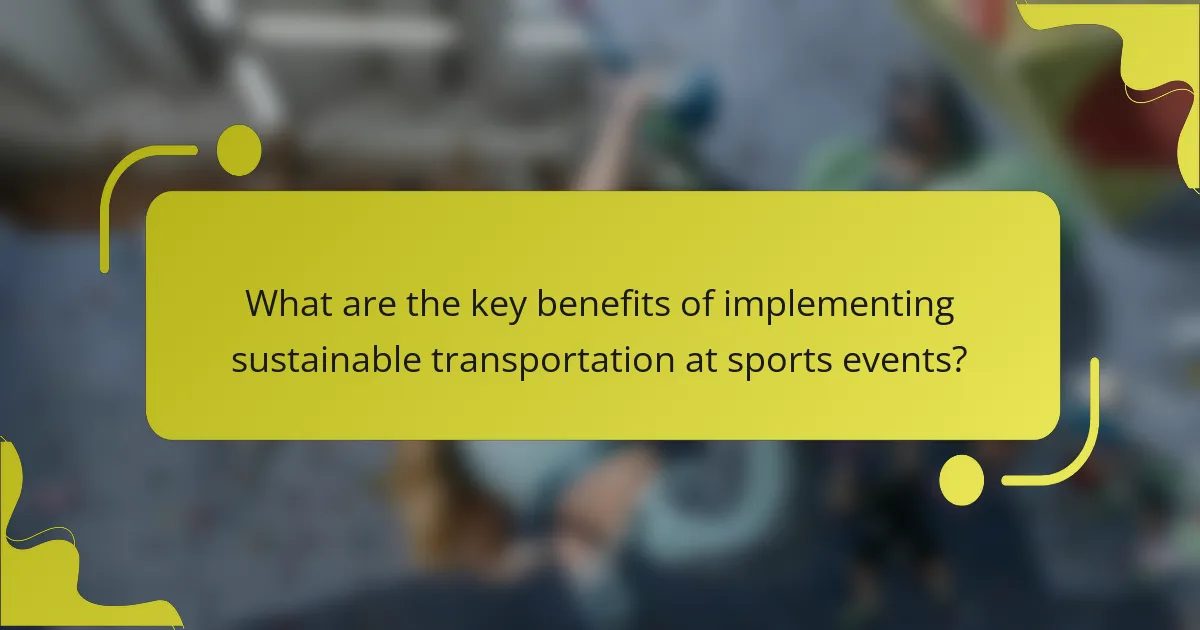
What are the key benefits of implementing sustainable transportation at sports events?
Implementing sustainable transportation at sports events offers significant benefits, including reduced carbon emissions, improved public health, and enhanced attendee experience. Sustainable options, such as public transit and cycling, decrease traffic congestion and promote eco-friendly practices. Additionally, these initiatives can lead to cost savings for organizers and foster community engagement. By prioritizing sustainability, sports events can set a positive example for environmental responsibility.
How does sustainability enhance the overall event experience?
Sustainability enhances the overall event experience by promoting eco-friendly practices and reducing environmental impact. Attendees appreciate the commitment to sustainability, which can improve their satisfaction and engagement. Sustainable transportation options, such as public transit and cycling, minimize congestion and emissions, creating a more enjoyable atmosphere. Additionally, these practices often lead to cost savings for event organizers, allowing for reinvestment in quality experiences.
What economic advantages can arise from sustainable transport initiatives?
Sustainable transport initiatives can enhance economic advantages by reducing costs, increasing accessibility, and promoting local businesses. These initiatives lower transportation expenses, leading to savings for both individuals and organizations. Improved accessibility boosts participation in sports events, increasing attendance and revenue. Local businesses benefit from increased foot traffic during events, fostering economic growth in the community.
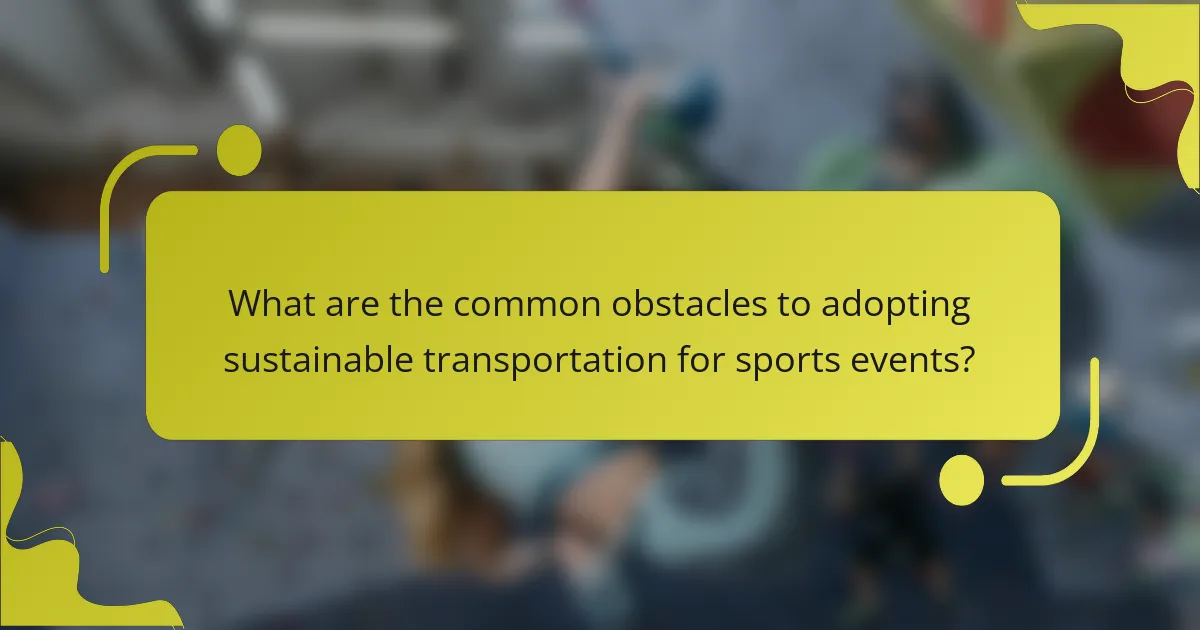
What are the common obstacles to adopting sustainable transportation for sports events?
Common obstacles to adopting sustainable transportation for sports events include high costs, limited infrastructure, and lack of awareness. These factors hinder effective implementation of eco-friendly options. High upfront costs can deter organizers from investing in sustainable solutions. Limited infrastructure, such as inadequate public transport options, restricts accessibility. Additionally, a lack of awareness among attendees about sustainable practices can reduce participation in eco-friendly transportation methods.
How can event organizers overcome funding challenges?
Event organizers can overcome funding challenges by leveraging sustainable transportation options. These options not only reduce costs but also attract environmentally conscious sponsors.
Utilizing public transport partnerships can lower expenses and enhance accessibility for attendees. Additionally, implementing bike-sharing programs encourages eco-friendly travel, appealing to a broader audience. Engaging local businesses for sponsorships related to sustainable transport can create financial support while promoting community involvement.
Lastly, applying for grants focused on sustainability initiatives can provide essential funding, ensuring the event aligns with environmental goals.
What logistical issues must be addressed for effective implementation?
Logistical issues for effective implementation of sustainable transportation options at urban sports events include route planning, capacity management, and stakeholder coordination. Addressing these ensures smooth operations and maximizes environmental benefits.
1. Route Planning: Identify efficient transport routes that minimize congestion and emissions.
2. Capacity Management: Assess and manage the volume of attendees to prevent overcrowding.
3. Stakeholder Coordination: Engage local authorities, transportation agencies, and event organizers for seamless collaboration.
4. Infrastructure Readiness: Ensure that public transport facilities can accommodate increased demand during events.
5. Communication Strategies: Inform attendees about available transport options and sustainability initiatives.
6. Accessibility Considerations: Ensure transportation options are inclusive for all attendees, including those with disabilities.
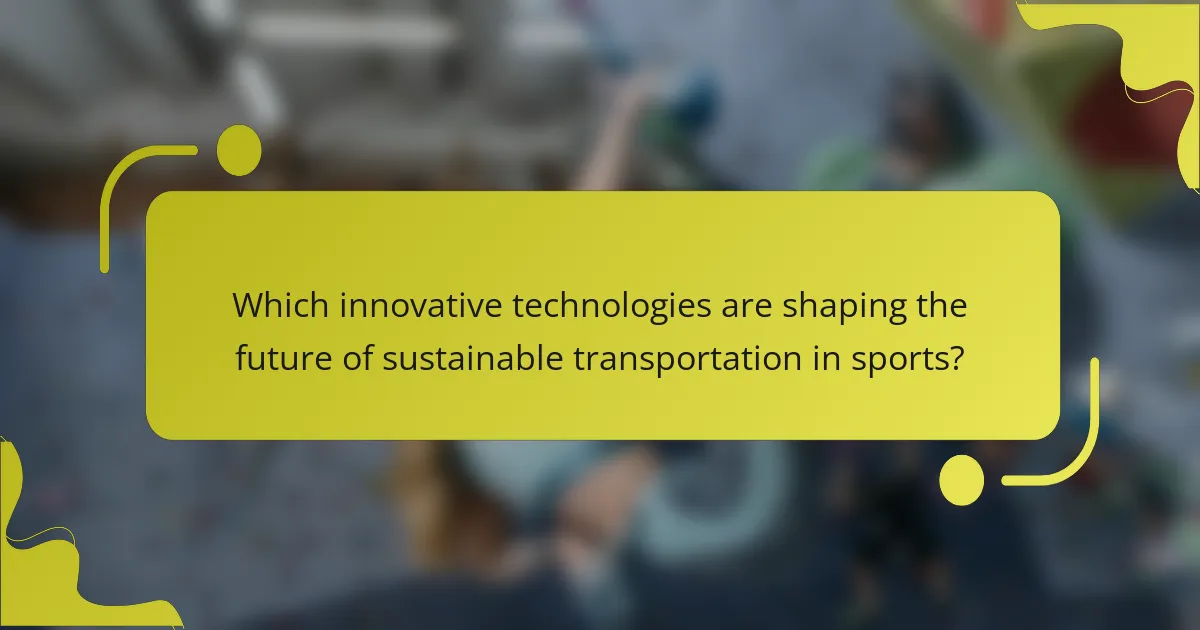
Which innovative technologies are shaping the future of sustainable transportation in sports?
Innovative technologies shaping sustainable transportation in sports include electric vehicles, bike-sharing systems, and smart public transit solutions. These technologies reduce carbon emissions and enhance accessibility for sports events. Electric vehicles offer zero-emission transport options, while bike-sharing promotes eco-friendly mobility. Smart transit solutions optimize routes and reduce congestion, enhancing overall efficiency. As a result, these advancements contribute to the sustainability goals of urban sports events.
What role does smart technology play in optimizing transport systems?
Smart technology significantly enhances transport systems by improving efficiency, reducing emissions, and optimizing routes. It enables real-time data analysis, facilitating better traffic management during sports events. For instance, smart traffic lights adjust to congestion levels, ensuring smoother flow. Additionally, electric and autonomous vehicles contribute to sustainable transportation, aligning with eco-friendly initiatives. Implementing these technologies can lead to a 30% reduction in travel time and a substantial decrease in carbon footprints.
How are apps and digital platforms enhancing user experience and efficiency?
Apps and digital platforms enhance user experience and efficiency by streamlining access to sustainable transportation options for urban sports events. They provide real-time data, enabling users to identify the most efficient routes and modes of transport. This reduces travel time and carbon emissions, aligning with sustainability goals. Additionally, platforms facilitate ride-sharing and public transport integration, promoting eco-friendly choices. Enhanced user interfaces improve engagement, making it easier for participants and spectators to plan their journeys effectively.
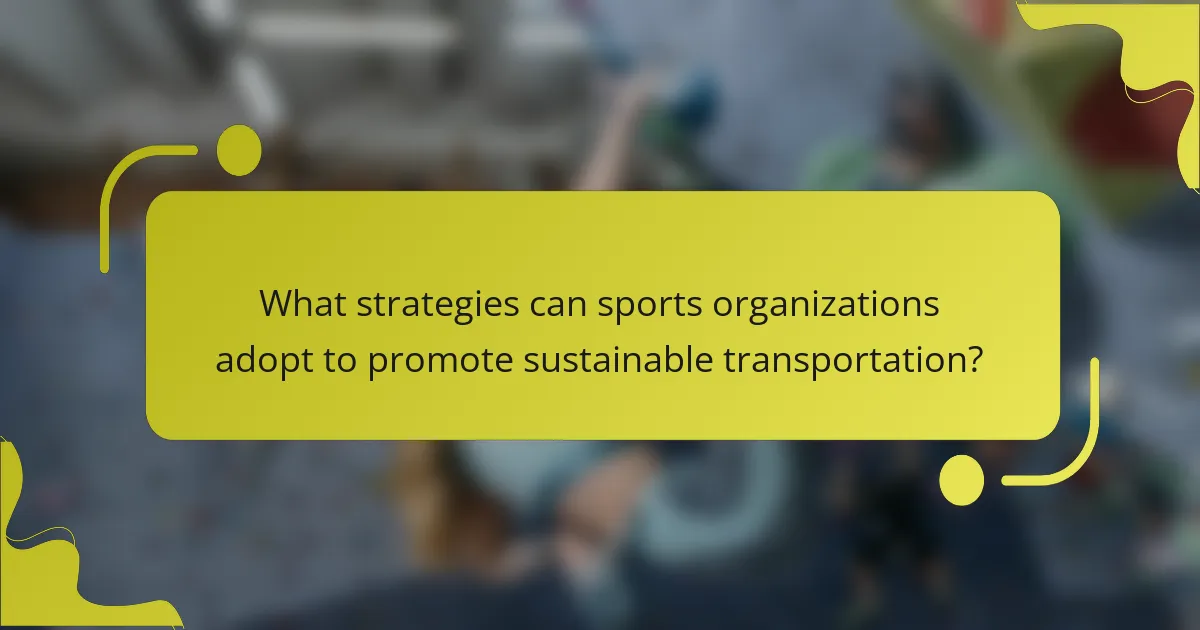
What strategies can sports organizations adopt to promote sustainable transportation?
Sports organizations can promote sustainable transportation by implementing various strategies. They can encourage public transit use by partnering with local transit authorities to offer discounted fares for event attendees. Additionally, organizations can create incentives for carpooling, such as reserved parking spots for carpool vehicles. Providing bike parking and promoting cycling can further reduce vehicle emissions. Organizing shuttle services from key locations can enhance accessibility while minimizing traffic congestion. Lastly, educating fans about the environmental impact of their transportation choices can foster a culture of sustainability within the community.
How can partnerships with local governments improve sustainability efforts?
Partnerships with local governments enhance sustainability efforts by integrating eco-friendly transportation options for sports events. These collaborations can lead to improved infrastructure, reduced carbon footprints, and increased public awareness. For instance, cities can develop bike-sharing programs and electric shuttle services to facilitate access to events while minimizing environmental impact. As a result, sustainable transportation becomes a key attribute of urban sports initiatives, fostering community engagement and promoting healthier lifestyles.
What community engagement practices foster support for sustainable initiatives?
Community engagement practices that foster support for sustainable initiatives include collaboration, education, and inclusivity. Engaging local stakeholders promotes ownership and accountability. For example, organizing community workshops raises awareness about sustainable transportation options for sports events. This approach encourages participation and builds trust. Additionally, partnerships with local organizations amplify outreach efforts and resources. As a result, these practices create a supportive environment for sustainable initiatives, enhancing their effectiveness and longevity.
What are the best practices for measuring the success of transportation sustainability efforts?
To measure the success of transportation sustainability efforts for sports events, track key performance indicators (KPIs) such as reduction in carbon emissions, public transit usage, and participant satisfaction. Establish baseline metrics before implementing changes to assess impact effectively.
Utilize surveys to gauge attendee perceptions of transportation options and their environmental awareness. Compare data across events to identify trends and improvements over time. Engage stakeholders for feedback to refine strategies and enhance sustainability practices.
What common mistakes should organizers avoid when implementing sustainable transport solutions?
Organizers should avoid common mistakes like inadequate stakeholder engagement, neglecting public transport integration, and overlooking the importance of clear communication. Failing to assess environmental impact can also lead to ineffective solutions. Prioritizing short-term solutions over long-term sustainability hinders progress.
